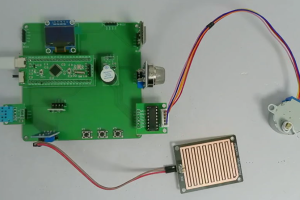设计说明书
总字数:20000+
基于单片机的智能窗户
摘要
随着人们对于便捷且舒适生活的追求趋势,智能家居正日益走向普及,传统窗户难以自动顺应环境的变化,同时也无法达成数据交互以及远程控制,基于此,一款基于单片机的智能窗户项目得以开发出来,借助多种传感器技术,达成窗户的智能自动化控制,以此提升家居的舒适性与安全性。智能窗户系统融合了环境监测以及自动调节功能,它运用DHT11模块实时监测温湿度情况,并且在条件出现偏离时自动调节窗户的开闭状态,温度控制相较于湿度控制更为优先,雨水检测模块在遭遇暴雨时会保持窗户处于关闭状态,防止雨水进入室内,SGP30模块负责监测二氧化碳浓度,当浓度超标时会优先进行通风操作。MQ-2模块用于监测烟雾,在出现危险时会自动开启窗户、窗帘并发出报警信号,系统还配备有手动控制按键以及OLED显示屏,用于显示实时数据,借助ESP8266WIFI模块,用户可远程控制窗户,提升便利性与智能化程度,本项目整合了多种功能,切实有效地改善了室内环境。可自动调节温湿度,保障居住的舒适度,同时减少手动操作,在如降雨或者空气质量出现问题等特殊情况下,可迅速做出响应,保障室内安全,远程控制功能使得用户可以随时管理窗户状态,这对于智能家居系统的建设而言非常关键,扩展了窗户的功能,还提供了智能、安全、舒适的居住体验。
关键词:智能窗户,单片机,传感器,WIFI模块
Smart Windows based on microcontroller
Abstract
Nowadays, people are increasingly pursuing a convenient and comfortable life. Under such circumstances, smart homes are becoming more and more popular. Traditional Windows have some shortcomings. They cannot automatically adapt to changes in the surrounding environment, nor can they achieve data interaction and remote control. Therefore, a smart window project based on single-chip microcomputers has been developed. This project utilizes a variety of sensor technologies to achieve intelligent and automated window control, which can enhance the comfort of the home and also improve safety. The intelligent window system integrates the functions of environmental monitoring and automatic regulation. It uses the DHT11 module to monitor temperature and humidity in real time. If the environmental conditions deviate from the set range, it will automatically adjust the opening and closing of the window. In terms of control, temperature control takes precedence over humidity control. The function of the rainwater detection module is that when encountering heavy rain weather, it will close the Windows to prevent rainwater from entering the room. The SGP30 module will monitor the level of carbon dioxide. Once the level of carbon dioxide exceeds the safety limit, ventilation will be given priority. The MQ-2 module can detect smoke. If smoke is detected, It will automatically open the Windows and curtains and trigger an alarm when a dangerous situation occurs. This system is also equipped with manual control buttons and an OLED display capable of showing real-time data. With the ESP8266WIFI module, users can control the Windows remotely, which increases the convenience of use and makes the Windows more intelligent. This project integrates multiple functions and can effectively improve the indoor environment. It can automatically adjust the temperature and humidity to ensure people live comfortably. It can also reduce manual operations. In case of special circumstances, such as rain or air quality problems, it can respond quickly to ensure the safety of the room. With the remote control function, users can manage the status of the Windows at any time. This is crucial for building a smart home system. At the same time, it can also expand the functions of Windows, providing people with an intelligent, safe and comfortable living experience.
Keywords:Smart Windows, microcontroller, sensor, WIFI module
目 录
1 绪论
1.1 课题研究背景及意义
1.2 课题国内外研究现状
1.3 课题研究内容
2 系统设计
2.1 系统架构
2.2 功能模块选型
2.2.1 主控芯片模块方案选型
2.2.2 温湿度检测模块方案选型
2.2.3 雨量检测模块方案选型
2.2.4 二氧化碳检测模块方案选型
2.2.5 烟雾检测模块方案选型
2.2.6 显示模块方案选型
2.2.7 无线通信模块方案选型
3 系统硬件设计
3.1 STM32F103C8T6主芯片模块
3.2 温湿度检测模块
3.3 雨水检测模块
3.4 CO₂检测模块
3.5 烟雾检测模块
3.6 步进电机驱动模块
3.7 WIFI模块
3.8 OLED显示模块
4 系统软件设计
4.1 开发环境介绍
4.2 系统主流程设计
4.3 OLED显示子流程设计
4.4 独立按键子流程设计
4.5 ADC模数转换子流程设计
4.6 温湿度检测模块子流程设计
4.7 SGP30模块子流程设计
4.8 WiFi模块子流程设计
4.9 步进电机子流程设计
5 实物测试
5.1 测试方案
5.2 智能窗户实物测试步骤
5.3 智能窗户实物测试结果分析
6 总结与展望
参考文献
致谢
附录1:原理图
附录2:程序
购买后可查看具体内容!

